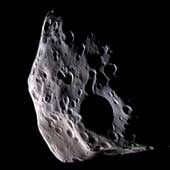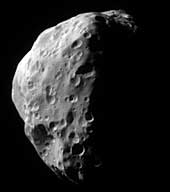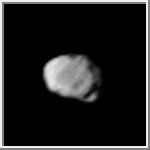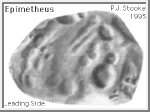
Saturn XI - 1980S3
Epimetheus [ep-eh-MEE-thee-us] is the fifth satellite of Saturn. It was discovered by R. Walker in 1980. Epimetheus was the son of Iapetus and brother to Prometheus and Atlas. Epimetheus means hindsight in Greek. It has an irregular shape with a size of 144x108x98 kilometers (89x67x61 miles) in diameter. It is traversed by several large and small grooves, valleys and ridges. Several craters larger than 30 km can be seen on its surface. The pervasive cratering indicates that its surface must be several billion years old. The above image shows the shadow of Saturn's F Ring crossing its surface.
Epimetheus and Janus share the same orbit of 151,472 kilometers from Saturn's center or 91,000 kilometers above the cloud tops. They are only separated by about 50 kilometers. As these two satellites approach each other they exchange a little momentum and trade orbits; the inner satellite becomes the outer and the outer moves to the inner position. This exchange happens about once every four years. Janus and Epimetheus may have formed from a disruption of a single parent to form co-orbital satellites. If this is the case, the disruption must have happened early in the history of the satellite system.
| Epimetheus Statistics | |
|---|---|
| Discovered by | R. Walker |
| Date of discovery | 1980 |
| Mass (kg) | 5.6e+17* |
| Mass (Earth = 1) | 9.3708e-08 |
| Radius (km) | 72x54x49 |
| Radius (Earth = 1) | 1.1289e-02 |
| Mean density (gm/cm^3) | 0.7* |
| Mean distance from Saturn (km) | 151,422 |
| Rotational period (days) | 0.6942 |
| Orbital period (days) | 0.6942 |
| Mean orbital velocity (km/sec) | 15.87 |
| Orbital eccentricity | 0.009 |
| Orbital inclination (degrees) | 0.34 |
| Escape velocity (km/sec) | 0.0322 |
| Visual geometric albedo | 0.8 |
| Magnitude (Vo) | 15.7 |
 Epimetheus: Up-Close and Colorful
Epimetheus: Up-Close and Colorful
With this false-color view, Cassini presents the closest look yet at
Saturn's small moon Epimetheus (epp-ee-MEE-thee-uss).
The color of Epimetheus in this view appears to vary in a non-uniform way across the different facets of the moon's irregular surface. Usually, color differences among planetary terrains identify regional variations in the chemical composition of surface materials. However, surface color variations can also be caused by wavelength-dependent differences in the way a particular material reflects light at different lighting angles. The color variation in this false-color view suggests such "photometric effects" because the surface appears to have a more bluish cast in areas where sunlight strikes the surface at greater angles.
This false color view combines images obtained using filters sensitive to ultraviolet, polarized green and infrared light. The images were taken at a Sun-Epimetheus-spacecraft, or phase, angle of 115 degrees, thus part of the moon is in shadow to the right. This view shows an area seen only very obliquely by NASA's Voyager spacecraft. The scene has been rotated so that north on Epimetheus is up.
The slightly reddish feature in the lower left is a crater named Pollux. The large crater just below center is Hilairea, which has a diameter of about 33 kilometers (21 miles).
At 116 kilometers (72 miles) across, Epimetheus is slightly smaller than its companion moon, Janus (181 kilometers, or 113 miles across), which orbits at essentially the same distance from Saturn.
The images for this color composite were obtained with the Cassini
spacecraft narrow-angle camera on March 30, 2005, at a distance of
approximately 74,600 kilometers (46,350 miles) from Epimetheus. Resolution
in the original images was about 450 meters (1,480 feet) per pixel. This
view has been magnified by a factor of two to aid visibility.
(Courtesy NASA/JPL/Space Science Institute)
 Epimetheus Revealed
Epimetheus Revealed
The Cassini spacecraft's close flyby of Epimetheus in December 2007
returned detailed images of the moon's south polar region.
The view shows what might be the remains of a large impact crater covering most of this face, and which could be responsible for the somewhat flattened shape of the southern part of Epimetheus (116 kilometers, or 72 miles across) seen previously at much lower resolution.
The image also shows two terrain types: darker, smoother areas, and brighter, slightly more yellowish, fractured terrain. One interpretation of this image is that the darker material evidently moves down slopes, and probably has a lower ice content than the brighter material, which appears more like "bedrock." Nonetheless, materials in both terrains are likely to be rich in water ice.
The images that were used to create this enhanced color view were taken
with the Cassini spacecraft narrow-angle camera on Dec. 3, 2007. The views
were obtained at a distance of approximately 37,400 kilometers (23,000
miles) from Epimetheus and at a Sun-Epimetheus-spacecraft, or phase, angle
of 65 degrees. Image scale is 224 meters (735 feet) per pixel.
(Courtesy NASA/JPL/Space Science Institute)
 Movie: Moon Shadow in Motion
Movie: Moon Shadow in Motion
The beauty and spectacle of celestial motion is captured in this short movie of a moon shadow darting across Saturn's rings.
Over the span of about an hour, Cassini's camera tracked the shadow of the small moon Epimetheus, orbiting beyond the rings, as it moved across Saturn's A ring in this movie made up of 21 images.
One of the happy results of Saturn's 29-year revolution around the sun is the changing elevation of the sun seen from the planet, and the changing elevation of the shadows of the rings and moons that the sun's apparent motion brings.
As Saturn approaches equinox, the angle at which the ringplane is inclined
away from the sun will continue to decrease until August 2009, when
equinox will bring about an alignment of the plane containing the rings
with the rays of the sun. Only around the time of equinox is a moon's
shadow cast on the rings rather than the planet. Between now and equinox
in August, the shadows cast by the moons on the rings will grow longer
with time.
(Courtesy NASA/JPL/Space Science Institute)
 Looking Down on Epimetheus
Looking Down on Epimetheus
From 34 degrees above Saturn's equatorial plane, Cassini gazed down at
Saturn's moon Epimetheus. The region seen here includes territory farther
north and east than that imaged in March 2005 (above).
The two largest craters visible here are the only officially named features on Epimetheus. The crater at the left (at about the 9 o'clock position) is named Pollux; the crater at lower left (containing a string of several smaller craters) is called Hilairea. Epimetheus is 116 kilometers (72 miles) across.
The image was taken in visible light with the Cassini spacecraft
narrow-angle camera on July 14, 2005, at a distance of approximately
87,000 kilometers (54,000 miles) from Epimetheus and at a
Sun-Epimetheus-spacecraft, or phase, angle of 95 degrees. The image scale
is 520 meters (1,710 feet) per pixel.
(Courtesy NASA/JPL/Space Science Institute)
 Epimetheus
Epimetheus
This is the highest resolution image of Epimetheus acquired by the
Voyager spacecrafts. Voyager 1 obtained
this photo on November 11, 1980. In this image, Saturn's F Ring
casts a shadow across Epimetheus' surface.
(Copyright 1999 Calvin J. Hamilton)
 Epimetheus, From Voyager 2
Epimetheus, From Voyager 2
This image of Epimetheus was acquired by the
Voyager 2 spacecraft on August 26, 1981.
Although the resolution is limited in this view, yet numerous
craters are visible.
(Copyright 1999 Calvin J. Hamilton)
 Epimetheus, From Voyager 2
Epimetheus, From Voyager 2
This low resolution image shows another view of Epimetheus as was
seen by the Voyager 2 spacecraft on August 26, 1981.
(Copyright 1999 Calvin J. Hamilton)
 Simple Cylindrical Map of Epimetheus
Simple Cylindrical Map of Epimetheus
This image is a Simple Cylindrical map of Epimetheus centered at 180 degrees
longitude. It was constructed from Voyager 1 and Voyager 2 pictures of
Epimetheus using a shape model of Peter Thomas.
(Courtesy A. Tayfun Oner)
 Topographic Map of Epimetheus
Topographic Map of Epimetheus
This is a topographic map of Epimetheus. It is based upon the shape model of Phil
Stooke. As with all maps, it is the cartographer's interpretation;
not all features are necessarily certain given the limited data
available. This interpretation stretches the data as far as possible.
(Courtesy A. Tayfun Oner)
 Conformal Projection of Epimetheus
Conformal Projection of Epimetheus
This image is a shaded relief map of Epimetheus, the smaller co-orbital
satellite of Saturn. As with all maps, it is the cartographer's
interpretation and not all features are necessarily certain given the
limited data available. This interpretation stretches the data as far as
is feasible.
This image shows two different views of Epimetheus in a Morphographic
Conformal Projection. One view shows the
leading side and the
other the trailing side.
(Courtesy Phil Stooke, NSSDC, and NASA)
Stooke, P. J., "The Topography of Epimetheus," Earth, Moon and Planets, 63 (1993), 67-83.

 Saturn
Saturn Pandora
Pandora Janus
Janus